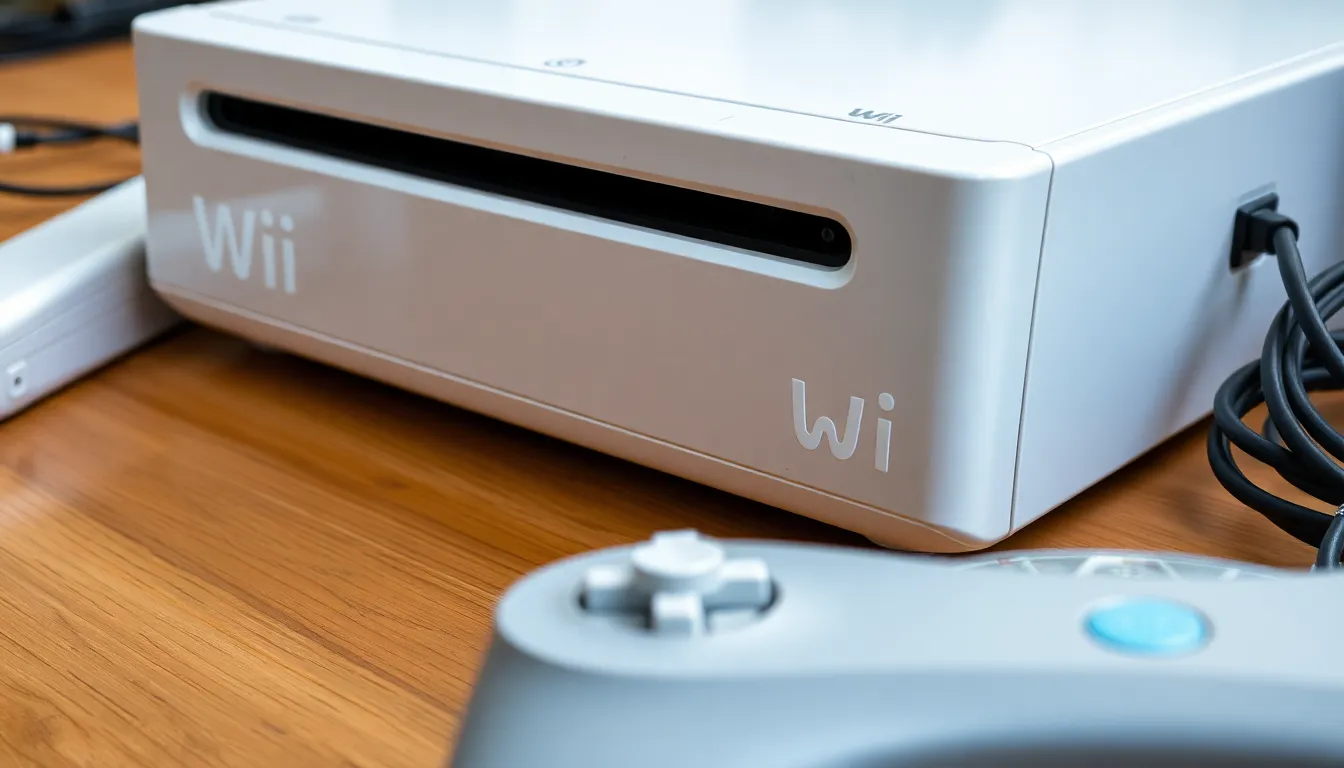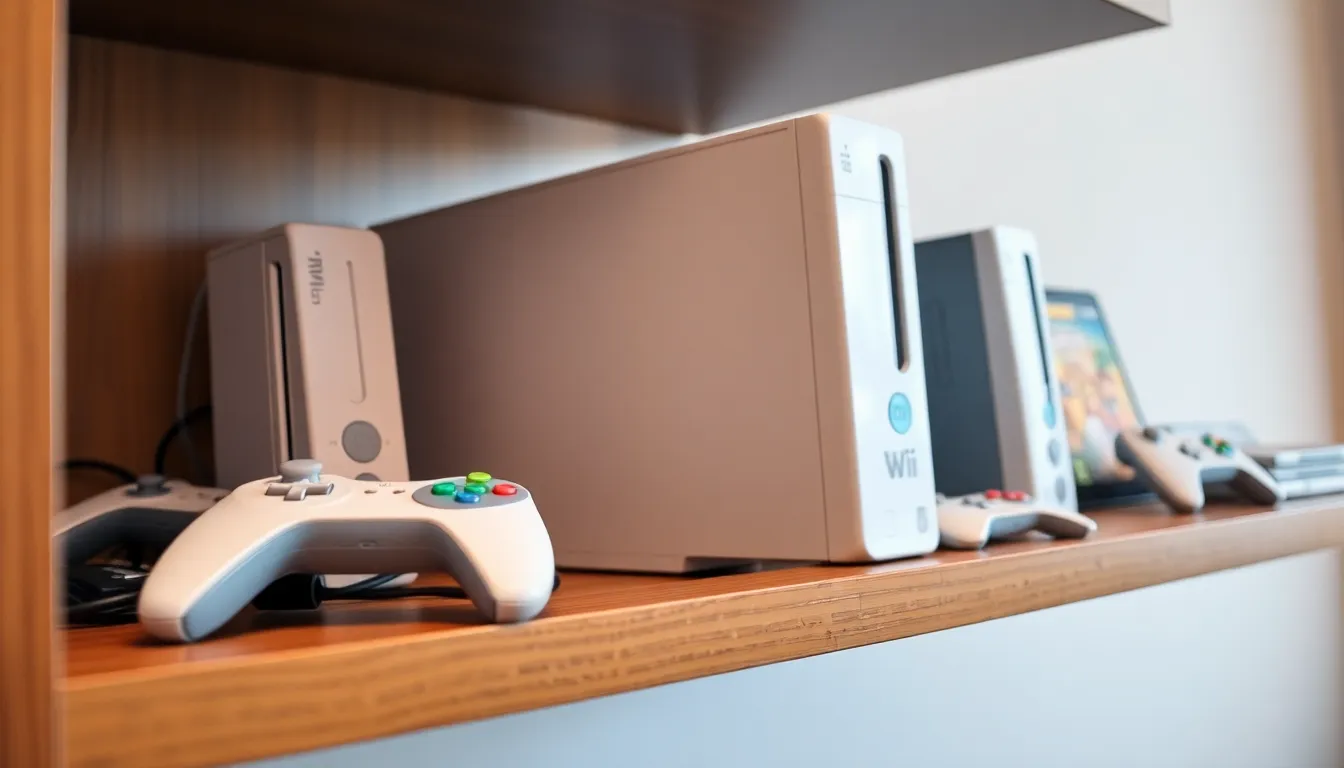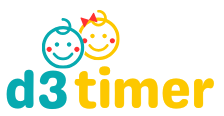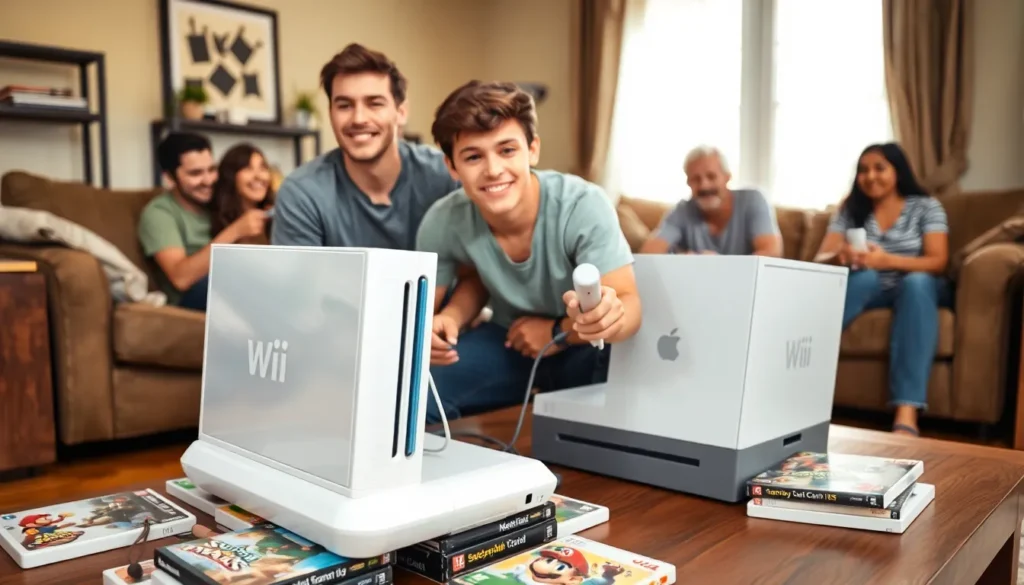Table of Contents
ToggleIn a world where gaming consoles come with price tags that could rival a small car, the Wii stands out as a delightful exception. This beloved console revolutionized family fun with its motion-sensing controls and a library of games that could entertain anyone from toddlers to grandparents. But what’s the real cost of diving into this nostalgic gaming experience?
Overview of the Wii Console
The Wii console redefined home gaming by introducing motion-sensitive controls. This design aimed to make gaming accessible to all ages, drawing families into the interactive experience. Unique features, like Wii Sports, showcased its capabilities, boosting its popularity significantly. Gamers could enjoy a wide variety of titles across different genres, catering to diverse tastes.
The console launched at a price of $249.99 in November 2006, positioning itself as a budget-friendly option compared to contemporaries. Market trends indicate that used models typically range from $50 to $150, depending on condition and included accessories.
By emphasizing social gaming, the Wii fostered a communal atmosphere, making it ideal for gatherings. Games like Mario Kart Wii and Super Smash Bros. Brawl became staples for parties and family nights. Its library featured titles appealing to casual gamers, balancing the gaming experience for occasional users and enthusiasts alike.
Investing in the Wii not only offered entertainment but also promoted physical activity through gameplay. This aspect resonated with health-conscious gamers, emphasizing fitness while having fun. Additionally, it incorporated online features and downloadable content, expanding the gaming experience beyond the physical disc.
Understanding the overall cost involves considering accessories, game prices, and potential online subscriptions. Accessories, such as the Balance Board and additional controllers, can increase spending by an average of $60 to $150 each. The total cost experience varies among users, influenced by gaming preferences and desires for extended play.
Factors Influencing Wii Console Cost


Multiple elements contribute to the overall cost of a Wii console. Understanding these factors provides clarity on pricing variations.
Supply and Demand
Supply and demand dynamics significantly affect the Wii console price. When demand exceeds supply, prices tend to rise. Limited availability of new consoles may lead to higher costs for new purchases. Conversely, an abundance of used models can drive down prices. Seasonal factors also come into play. During holidays, demand spikes, often resulting in increased prices. Regional factors may impact availability, making certain areas more expensive than others. Prices for used units typically range from $50 to $150, depending on local supply conditions.
Condition of the Console
Condition plays a crucial role in determining the price of a Wii console. Well-maintained consoles fetch higher prices than those showing signs of wear and tear. Factors such as scratches, dents, or malfunctioning components influence buyer perceptions and willingness to pay. Bundles that include accessories, like controllers and games, can add significant value. Another consideration involves whether the console includes original packaging; this can enhance collectors’ interest. Prices vary accordingly, with higher-quality items commanding premium rates.
Comparing Prices Across Retailers
Wii console prices vary widely among retailers, depending on factors like condition and included accessories. Understanding these differences helps buyers make informed decisions.
New vs. Used Pricing
New models of the Wii often retail around $249.99, aligning with the original launch price. Used consoles typically range from $50 to $150, reflecting the unit’s condition and market demand. Retailers might offer significant savings on refurbished units, which often come with a warranty. Condition impacts pricing; well-maintained systems can sell closer to their retail price, while those with visible wear generally cost less.
Bundle Offers and Discounts
Bundle offers frequently include additional controllers or games, increasing value for buyers. Retailers often adjust prices during holidays, so shoppers can find discounts on popular bundles. For instance, bundles featuring games like Mario Kart Wii may draw more interest, resulting in promotions. Discounts can fluctuate, especially during seasonal sales or clearance events, so keeping an eye on multiple retailers benefits potential buyers.
Historical Trends in Wii Console Pricing
Initial pricing for the Wii console began at $249.99 upon its launch in November 2006. Since then, the price has fluctuated based on various market conditions and consumer demand. Retailers noted a significant increase in price during holiday seasons, reflecting heightened demand during these periods.
Used models generally range from $50 to $150, depending on condition and included accessories. Well-maintained units, especially those with original packaging, tend to fetch higher prices. Consumers commonly seek out bundle deals that include extra controllers or popular games, enhancing perceived value and overall experience.
Data show refurbished units frequently come at a lower cost than new models, yet maintain reliability with warranties included. Historical price trends reveal that the Wii remains a budget-friendly option for family entertainment compared to pricier gaming systems. Seasonal promotions often adjust prices, allowing potential discounts on popular bundles, particularly around holidays and special sales events.
The longevity of the Wii’s appeal is reflected in consistent pricing trends over the years, despite the introduction of newer gaming consoles. Consumers seeking nostalgia often find that the initial launch price remains competitive, emphasizing the console’s enduring value in the gaming market.
Future of Wii Console Cost
Anticipated changes in the Wii console market hinge on several evolving factors. Seasonal demand spikes during holidays frequently lead to temporary price increases. The condition of individual consoles influences pricing actively; well-preserved units typically command higher rates compared to those showing significant wear and tear. Bundled offers are expected to enhance perceived value, particularly when they include controllers or popular games.
Trends indicate that used Wii consoles maintain a stable demand due to nostalgia. With prices generally ranging from $50 to $150 for these units, shoppers often seek deals on refurbished consoles, which sometimes come with warranties. The consistent pricing of newly manufactured models reflects the enduring popularity of the original $249.99 launch price.
Market dynamics push retailers to adjust prices based on stock levels. During periods of high demand, customers may face increased costs, while sales events can provide attractive discounts, especially on bundle options. Online resources remain pivotal for obtaining competitive pricing insights, ensuring that consumers navigate the market effectively.
The potential for online subscriptions also impacts overall pricing considerations. As consumers engage with downloadable content, additional costs could increase spending by an estimated $60 to $150. Despite newer consoles dominating the market, the Wii’s unique gaming experiences continue to resonate, maintaining its place as a cost-effective option for family entertainment.
Looking ahead, the intersection of nostalgia, community engagement, and shifting market conditions suggests that the Wii console will retain significant value for gamers seeking affordable fun.




